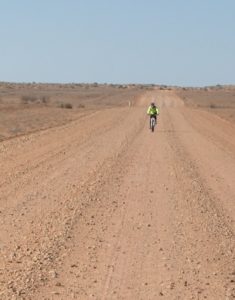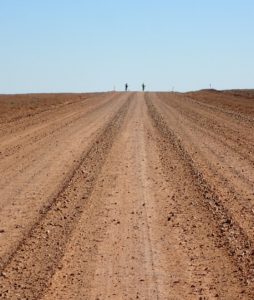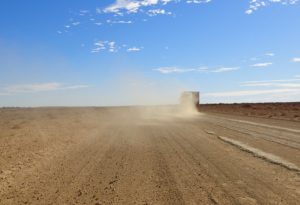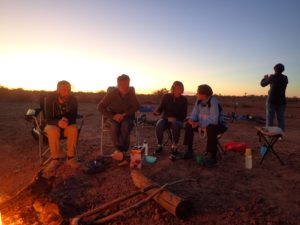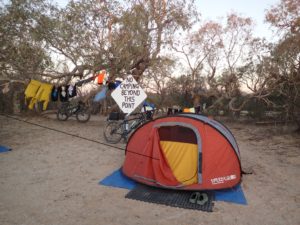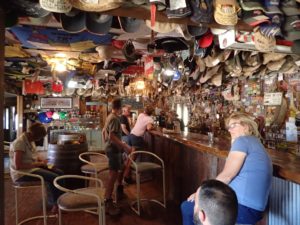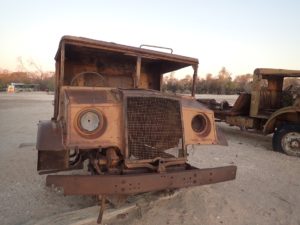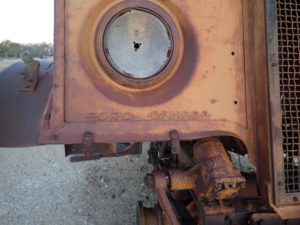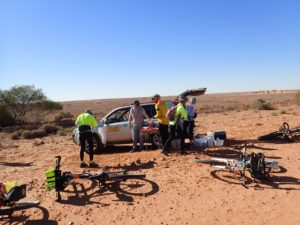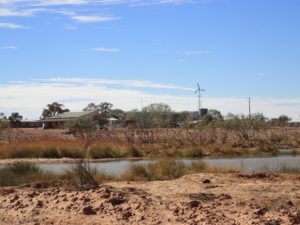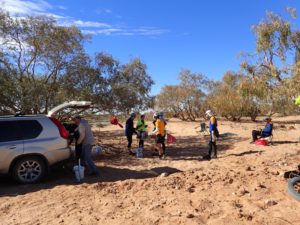May 12 to 14, 2019
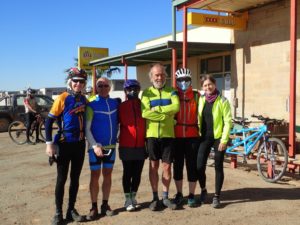
The Birdsville Track is an iconic route across the Australian outback. Once the domain of camel drivers and bullock trains it is over 540 kilometres of rough dirt, stone, sand and gravel road with services ranging from sparse to non-existing. Its most common visitors are the long road trains hauling cattle and sheep, four wheel drive adventurers and the denizens of the lonely cattle stations. Then there are the occasional hardy trekers on bicycles like us. As we left Marree we noted the sign said the road was open to Mungerannie but closed from there to Birdsville. We had a three day ride to Mungerannie and left with hopes that during that time the route beyond would open. A double barrelled flood event had washed out some sections of the road and created a five kilometre wide flooded area as we had some hope that we would be allowed to work our bicycles around the flooded area.
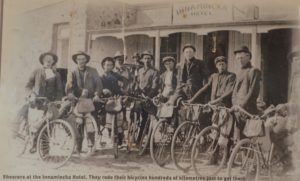
The Birdsville Track is steeped deep in Australian history. Along its route Tom Kruse drove the royal mail through conditions that would have stifled a lesser man. Through these dry lands trekked Wills and Burke on their ill fated journey from coast to coast across the Outback. It is a goal today for many a four wheel drive, cattle station transport, vacationing caravaner and bicyclists such as us. The bicycling tradition in the Outback goes back many years to a time when transient sheep shearers would use them to ride from station to station during the time when wool was being harvested. Our goals are somewhat less ambitious as we will travel better maintained roads and have the luxury of vehicle support along the way.
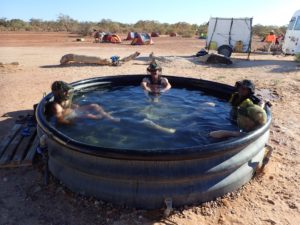
Our first night was spent at an oasis in the Outback where warm water from the aquafier gushed to the surface providing warm showers and hot soaking pool. Flies were everywhere and they swarmed our bodies, not biting but looking for moisture. They are one of nature’s more benign curses. Our shower was from the same hot subterranean source augmented with some cool rainwater from a tank above the shower hut. Unfortunately, when the cold water was turned the entire top of the hut leaked the cool water making it impossible to keep anything above head height dry. A solution was found by putting your dry clothing into a bucket and hanging it from the ceiling near the one dry corner of the hut.
There is a beauty to this large and open land where population is measured not in people per square kilometre but in square kilometres per person and where vegetation and water are sparse. The road is a mix of dirt, sand, rocks with a bit of gravel and clay sprinkled in wherever the road crews think they can spare it. Mostly it is rough and heavily corrugated from the heavy trucks and four wheel drive vehicles that speed along it in a cloud of dust. Outside the wheel tracks the landscape is mostly wide, rock strewn, open spaces with the occasional gum tree and spiky spinfex grass with a clump of cattle thrown in for interest. Andy, our primary bus driver and all around go-to guy calls it, “a brown and rick land.” It is definitely brown and no doubt that it has and continues to make many Australians rich but you better be prepared to carry your own provisions unless you have generations old aboriginal knowledge.
The next day another 80 or so kilometres took us to our next night’s camp at Cooper’s Creek a well off the dusty road spot with plenty of shade but no available water. We improvised with some sun warmed shower bags and a fold up cabana to scrub off the dust of the day’s ride. Dinner was by the campfire with John playing his recorder to round out the evening. The morning brought a gusting tailwind that pushed our bikes along the rough and rutted roadway all the way to a somewhat civilized oasis known as the Mungerannie Hotel.
Ah, the Mungerannie Hotel! A welcome sight to travelers of all conveyances and none more so than to some thirsty, dust choked folks on bicycles. Inside its cool, dark and mostly fly free spaces you will find Phil with his time worn, well shaped, grey beard and ancient Australian cattleman’s hat. Phil has a jolly disposition, a ready smile and a twinkle in his eye that lets you know that life here need not be taken too seriously. His fridge is well stocked with cold beverages even in this no too busy season. The ceiling is decorated with numerous hats of various types but mostly of the cattleman variety. There are signs attached to many of them indicating who left them and when. The occasional bra and a few other garments round out the collection. The walls are covered with bumper stickers from all over advertising places, political expressions, sour jokes and stupid sayings. It is a unique and charming place. Phil seems to run the establishment by himself for the most part until business picks up and he does everything from fixing flat tires to pumping gas and cooking meals. In between he tends bar and looks after the campsite and guest rooms. All this done with a light and easy manner. During our stay he shanghaied some local folks to help serve our group of 19 hungry travelers at dinner time.
Our plan was to spend the next day here in Mungerannie with the hope that the Birdsville Track would open up for us ti travel the rest of the way to Birdsville. It is amazing that in a desert area that has had little rain over the past month that a road should be closed due to flooding but such is the nature of this part of the Outback. Two major rain events during the previous two months had loaded the up-gradient lands and that water was now slowly working its was through to Lake Eyre below Birdsville. The result was a five kilometre break in the road due to flooding. While the water was dropping it was still going to take a week or more before even the toughest four wheel drive vehicles could make it through. After exploring every possible alternative, Ralph, the tour organizer, decided we had to make a detour that involved backtracking over the roads we had travelled the past four days. Normally we would have biked another four days to Birdsville. Instead we would spend five hot and sticky days in a bus to get there.

